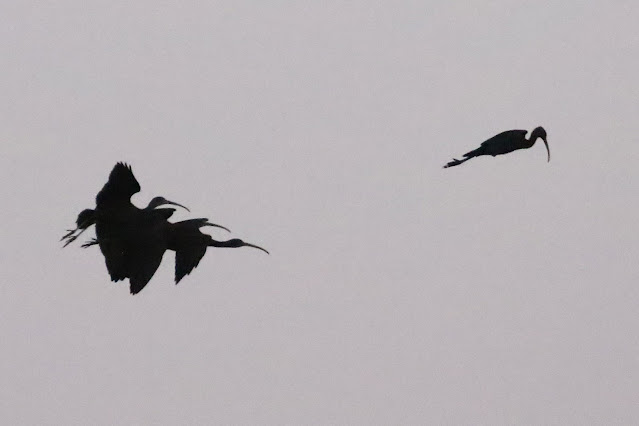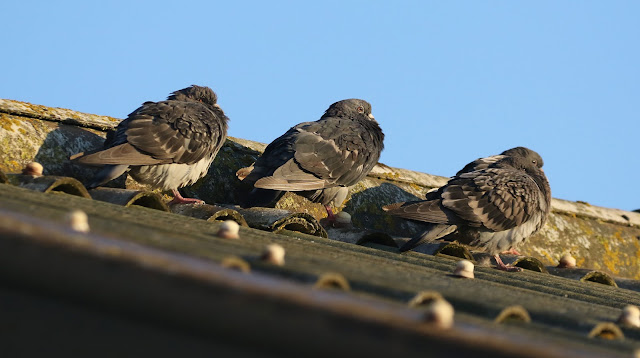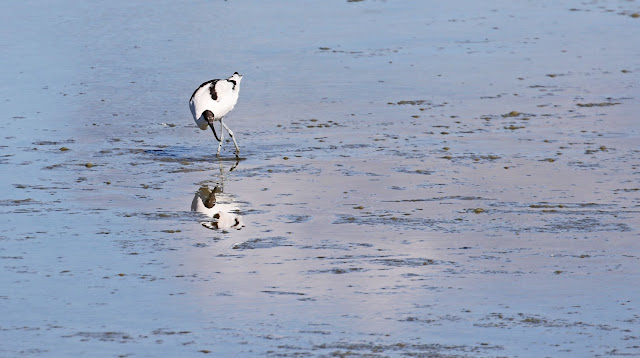I arrived at the sea wall at Hill Head with the sun still to arise, the tide was high and the skies clear and with that orange glow away to the east of the pre-dawn. It was though very cold, the first time this autumn, the temperature leaving home was just above freezing and the early morning conditions demanded a hat and gloves.
The gulls were flying around duck bay, with movements back and forth to the sea. Cormorants were also moving, their dark shapes heading out to sea from up river. There was a group of what I thought were Cormorants coming out from the south scrape, as they came towards me I realised that yes there were a couple of Cormorants, but there was also four unmistakable shapes, curved bills and trailing legs, the four Glossy Ibis that had been resident in the area for several weeks.
As they circled one or two would beak off and one came quite close but still in silhouette
Prehistoric shapes as they came together.
Here the four are joined by a Cormorant. Not sure who is mixed up here, the Cormorant or the ibis. They are gregarious birds and seem to gravitate towards black birds of similar size. last year the Warblington Ibis was seen associating with Crows and Rooks
Not sure where the fourth bird went.
All four back together again.
I don't think there is any other bird that looks so distinctive in silhouette as the Ibis. Here you can't seen the spectacular plumage that shimmers petrol colours in the sunshine, but it doesn't take from the sight of the bird.
I could see Ian's van coming past the visitor centre and hoped they would make a low pass over it, but they turned and headed back towards the reserve, dropping onto the south scrape just as Ian pulled up in his van next to me.
The sun was now just rising and the sky's colours were changing once again, slashed across the sky were vapour trails, like pencils my grandson said when he first saw them in the sky.
Then the Glossy Ibis were back, coming up from the south scrape and flying over the sailing club and out over the sea.
Synchronised
All four together circling around against the golden sky.
They flew over Duck Bay and then headed along the coast over Brownwich on their way to their favoured feeding area around the Meander Pools at Hook.
The Common Sandpiper were still around, one flew over the sea wall just as the Ibis were leaving. We walked to the Haven to check from the bridge, but paused on the way to take in the effect of the sun rise on the beach behind the sailing club.
The wider scene looking to the east and Lee-on-the Solent.
There was no sign of the Kingfisher at the bridge, but yet another Common Sandpiper flew in and landed on the boat ramp.
Then it flew out across the harbour, flying across the reflections of the boats and breakwater.
Unusually a Coot came from around the breakwater and headed into the harbour.
The sun reflecting the breakwater into the calm waters of the harbour.
The distant Isle of Wight, with a build up of cloud above it.
We decided to walk the Canal path, but stopped off to check the area around the chalets. The Feral Pigeons were warming up on the roof of the first chalet.
There was a little bit of movement in the bushes but nothing to stir the imagination so we headed to the canal path. A couple of Reed Warblers called from within the reeds and as we passed through the gate there was a lot of movement and contact calls. The majority of the birds though were Chiffchaff, showing briefly in amongst the sallow, willow and hawthorn.
As well as the warblers there were plenty of Blue and Great Tits.
Every so often there was the tacking call of Blackcap, with both male and female. This male had caught one of the many wasps, holding it by the abdomen.
There were plenty of cattle in the meadows, but no sign of any Yellow Wagtail. There is now a good size herd of Highland Cattle, always photogenic.
Whilst the majority of the small birds were Chiffchaff and Blackcap there were also a few Willow Warblers.
It was cold out of the sun, but he sun's rays were warming and there were several Speckled Woods to be seen.
Just over half way the canal path opens up into fields and a small reed bed. At the top of one patch of reeds was a female Reed Bunting, probably taking in the warming sunshine after what must have been a shock over night.
A male was also close by.
We walked to Posbrook, where the floods were still very dry. In the grass though was a Fox. Unfortunately I missed the pounce, but it had caught something and laid with its head in the grass and beautiful brush held aloft.
Then head up it was eating something.
With nothing of interest around the Bridge Street floods we turned back. Earlier we had seen a male Roe Deer, but now there was a female and young kid.
On reaching the field in front of the thatched cottage there were several horses in the field and with them an egret. At first we were not sure if it was a Little Egret, the bill was black and we couldn't see it clearly. Then it flew and we knew immediately that it was a Cattle Egret, the dark bill identifying it as an immature bird.
It flew towards us passing over our heads and then turning to fly up the valley, towards Posbrook and Bridge Street.
Ian tried to follow it but I stayed and above a Sparrowhawk appeared above me.
It then stooped into a large flock of hirundines, but was not successful and as a result the hirundines turned on the Sparrowhawk, the element of surprise gone.
The walk back to the sea wall did not produce anything new, just a lot of common warblers once again. At the cars a Common Sandpiper was feeding on the mud in Duck Bay and could be seen well from the road.
Looking across the bay I could just make out a sunbathing Water Rail on the edge of the reeds>
A redshank was feeding close to the reeds and the composition lent itself to a black and white image.
At the bridge again no Kingfisher, but a feeding Little Grebe.
From the visitor centre we headed back to the west side of the reserve and the Meon Shore Hide. It was quite busy as you would expect with only one hide worth visiting on the west side open. Apparently the reason for the closure of the Spurgin and Pumfrett hide is due to the damage to the bridge that leads to both, a bridge that has iron girders and concrete, but rotting wood planks.
Several Avocet were feeding close to the hide, they were mostly juvenile birds, showing some grey and brown in the plumage.
As always they lend well to a black and white image.
The reflections were very good in the shallow water of the scrape. A Lapwing feeding, reflected mirror like in the water
Another Avocet.
The main attraction today was a Little Stint. When we arrived it was feeding away to the right, hiding behind the reeds with Dunlin. But eventually it, along with the Dunlin, flew closer and in front of the hide.
Here alongside a Dunlin for comparison
The
Little Stint is a tiny wading bird with a short straight fine black bill and
medium-length black legs. It is brownish-grey above (grey in winter) and it is
very white underneath. Autumn birds have two pale stripes or 'braces' down the
back.
It is a passage migrant, with most birds being juveniles seen in autumn. It is
much scarcer in spring, when small numbers of adults are seen, and a very few
birds spend the winter here, most migrating to Africa. It is most often, like here, seen with
feeding dunlin.
From nowhere a Mediterranean Gull appeared, the brilliant white plumage standing out as it flew off to the left of the hide.
The view from the Meon Shore hide, in black and white of course.
The clouds were reflected in the shallow waters of the scrape and this produced the ideal scene for the feeding Avocet.
After something to eat we headed for the east side, stopping of to check the Sanderling on the beach behind the marina. Not the largest gathering, but I am sure the numbers will grow as we go into the winter.
With them, a few Ringed Plover.
Still no Kingfisher, but the reflections were now even better to frame the Little Grebe.
Entering the east side we were struck but the condition of the leaves on the Alder. The leaves resembled fish bones and many had been devoured by a large number of Alder Leaf Beetle. The Alder Leaf beetle is an 7-8 mm long dark metallic blue leaf
beetle that feeds on alder and is occasionally found on other deciduous trees
such as beech, hazel and hornbeam. It overwinters as adults which emerge
in the spring, sometimes in large numbers.

Adults emerge from soil and leaf litter where they
have been overwintering in early spring, they are winged and capable of
flight. New generation adults can be found from mid summer.
We visited the two hides with very little about of interest. What was impressive was the view looking north from the Meadow Hide, again in black and white.
Walking back along the board walk there was a resting female Common Darter.
At the visitor centre a Willow Warbler.
It was now mid afternoon and we were deciding to call it a day, as we approached the cars I just wanted to check a small duck feeding on the mud to the left side of Duck Bay. As I approached the fence I noticed a brown bird standing close to the shore and was quite surprised to find it was a Water Rail right out in the open.
It must have realised it was out in the open and suddenly decided to move across to the safety of the reeds.
It then decided to come out again, walking past the small duck that I had forgotten to check but was in fact a Teal.
And out into the open once again.
But then returned to the mud and waded a little further out.
It then stretched the neck and eventually flew across the water to the reed bed on the other side.
We stayed, watching and waiting to see if it appeared again, quite taken aback by the fact that it was so out in the open. The view again looking north in black and white.
A Little Egret stood by the reeds, the white plumage reflected in the water.
Then I heard a familiar call, pinging coming from the reeds to our right. It took a while but then one flew up but dropped back into the reeds. Then we could see them, two birds, feeding at the base of the reeds.
Probably a female and juvenile male, feeding on the fallen seeds at the base of the reeds.
Then the Water Rail appeared briefly once again.
Then some more views of what was my first Bearded Tits of the year.
The day started with some different but great views of the Glossy Ibis, a nice view of the Cattle Egret and finished with an unprecedented view of a Water Rail out in the open and the added bonus of a pair of Bearded Tits































































































No comments:
Post a Comment